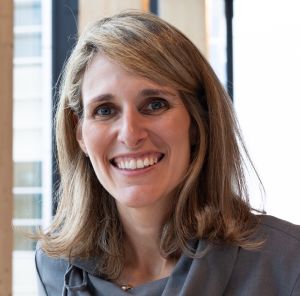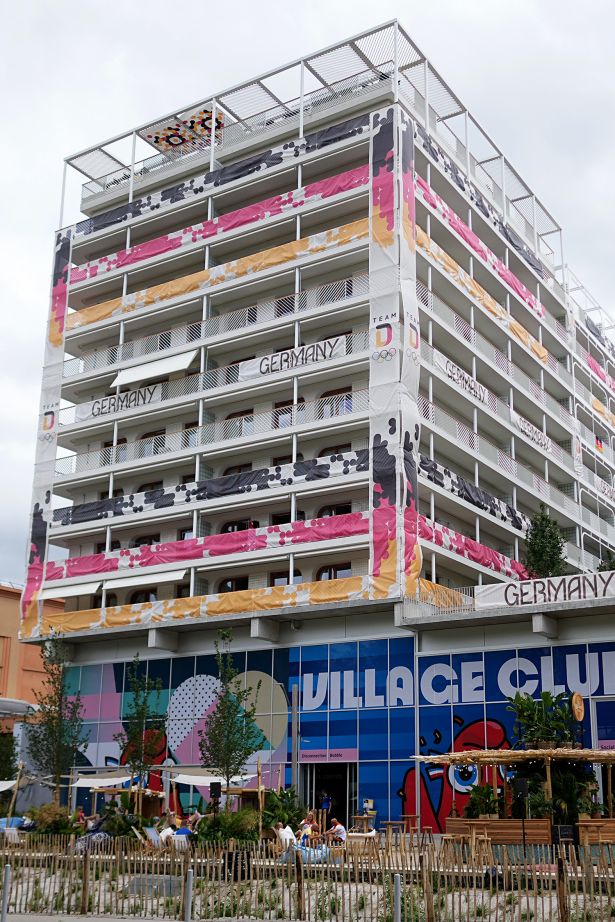Paris Olympics Leans Into Sustainability in Construction and Operations
It’s what’s not getting built, too, that counts
By Anna Staropoli July 24, 2024 7:00 am
reprints
While Olympians spike volleyballs in front of the Eiffel Tower and swimmers race across Paris’ revitalized Seine River, the City of Light bears yet another set of responsibilities for the 2024 Olympic and Paralympic Games: to house, feed, and transport thousands of athletes and millions of spectators with as little long-term environmental and social impact as possible.
In Paris’ north suburbs of Saint-Denis, Saint Ouen and L’Île-Saint-Denis, the Olympic Village is trying to meet these demands through a combination of new and existing commercial infrastructure. Also, given the scale and scope of the Olympic Games, hospitality brands, mass transit systems and the like have collectively adopted a live-work-play approach to assemble the Olympic Village.

“Paris is really into that 15-minute city and mixed-use and quality of life,” said London-based Tayomara Gama, Gensler’s sports practice leader. “So, you need to incorporate that in the village.”
With the right investments, Paris’ Olympic Village may even become more than a village. The city has leveraged the Olympic Games to redevelop neighborhoods and embrace future-forward infrastructure that outlasts this summer’s two weeks of sporting events. Balance beams and basketball nets may characterize Paris’ Olympic-worthy arenas, but it’s sustainability and accessibility that define this year’s village — and that may reshape France’s capital region.
“I think the most important change on the development of the Paris region will be registered in the housing market, with all the developments down around or down with the Olympic Village,” said Cyril Robert, Savills’ head of research in France.
Like many global cities, Paris and its wider region is facing a housing crisis. The city clocks some 25,000 inhabitants per square kilometer, or nearly 10,000 inhabitants per square mile, so people often have to move farther outside the city center to find housing, said Robert.
The Olympics, however, has accelerated development in the north suburbs, resulting in future housing and transportation opportunities. French hospitality company Accor is operating more than 90 buildings with 16,000 beds (constructed by Olympic developer Solideo) in the Saint-Denis athlete and media villages.
“The buildings we will be operating are configured as apartments, so they can be used by people after the Games,” Patrick Mendes, Accor’s CEO of premium, midscale and economy brands in Europe and North Africa, told Commercial Observer via email. “They required substantial modification for our teams who are used to operating in a hotel environment.”
Following the Games, athlete housing will be converted into a total of 2,500 homes, a student residence and a hotel, as well as a combination of park, retail and office space, according to the Olympics site. The media village likewise equates to 1,300 housing units. As for getting to those buildings, the Games accelerated the completion of Line 14 on the Grand Paris Express, the transit system which runs between Saint-Denis Pleyel and Paris-Orly Airport.
On the edge of the city, Saint-Denis “always needed investment; it needed this push,” said Gama, who compared the neighborhood to London’s East Village, site of the 2012 Olympic Village. Those Games resulted in a complete rebrand of the East Village, thanks in part to the media buzz surrounding it, she added.

Still, while the Olympics is tracking positively for new development north of the city center, the changes have pushed existing inhabitants — many of whom are squatters — out of Seine-Saint-Denis. Nearly 27 percent of the population of Seine-Saint-Denis region where Saint-Denis is located lives below the poverty line, per a Savills Olympics report. Approximately 80 percent of the Olympic Games’ public investments have been made in this area.
This isn’t the first time sports have reshaped the area north of Paris. In 1998, France organized soccer’s World Cup in the former industrial and brownfield region of Saint-Denis, which resulted in some 4.3 million square feet of new offices, said Robert.
Those buildings, however, have become outdated. “What was appreciated 20 years ago is not appreciated by tenants and users today,” said Robert, who noted that people today prefer mixed-use buildings to those that are 100 percent office.
“Now, it’s a weakness,” he said. “You have a major vacancy rate within Paris, and, to be honest, the Games will not change that because you have to really block this territory by mixing the uses.” (After the Games, however, the athletes village in parts of Saint-Denis, Saint Ouen and L’île-Saint-Denis will house nearly 1.3 million square feet of offices and city services, according to the Olympics website.)
Beyond accommodations, Paris’ Olympic Village includes dining facilities, health care clinics and security infrastructure, as well as space for socializing and infrastructure associated with sustainable solutions for waste management. Intangible facets of a city, such as its cuisine, also help create a village that’s attractive to athletes.
The bones of an Olympic Village are therefore somewhat ubiquitous across host cities, though the composition of a village is not one-size-fits-all. “Trying to replicate something that was done before, I think, is a recipe for a mistake,” said Gama. “It’s really about interpreting the community.”
For instance, Rio de Janeiro — which hosted the 2016 Summer Olympics — housed select athletes on cruise ships, leveraging its location on the sea. “Rio is on the coast and Paris is not, but you have creative ways to cater for that demand that will take perhaps only three weeks instead of building majorly,” said Gama.
Paris, especially, also stands apart as it already hosts millions of tourists in non-Olympic years. The city ranks as one of the world’s most visited destinations, with an average of 50 million tourists per year. Given the city’s typical numbers, some preliminary research has suggested that the Olympics will not drastically impact Parisian tourism and, therefore, its infrastructure.
For the Olympics, however, Charles de Gaulle Airport is projected to see 300,000 passengers daily — 100,000 more than its daily summer average. Rather than invest in major infrastructure to grow that 50 percent for the Games, Paris is managing these crowds operationally, said Gama.
Similarly, Accor has roughly an 80 percent occupancy rate for its Parisian hotels during the Olympic period, and expects a final occupancy rate between 80 and 90 percent. “Compared to non-Olympics years, August is not usually the most crowded month of the year in Paris, so the figures are expected to be positive,” said Mendes.
In preparation for this better-than-average occupancy, Accor has been planning ahead, with employees focused fully on the job for the last two years. “We needed more than 700 people to operate these [media and athlete] villages, so we started our recruitment sessions and trainings back in September 2023,” said Mendes.
Paris had seven years to prepare its infrastructure, though future host cities may have even more time. In 2017, the International Olympic Committee simultaneously announced Paris for 2024’s summer Olympics and Los Angeles for 2028’s. L.A therefore received an 11-year heads-up — a notice Gama fully endorses.
“If Paris had had four years longer, like L.A. is going to have and Brisbane [Australia] … they could have done [an] even better job,” said Gama, who highlighted the time it takes to remodel buildings, which often proves more complex than undertaking new construction. A longer lead time likewise allows host cities to find creative, sustainable solutions, and learn from and adapt to the lessons of prior Olympic cycles.
That’s not to say that Paris hasn’t planned well, especially when it comes to inclusive and sustainable design. A future-forward mentality has become a hallmark of this year’s Games, thanks to an increased focus on sustainable design and technology, accessibility and — indeed — a deliberate lack of air conditioning.
While Paris remains one of the world’s most visited cities, the Olympic Games provides an opportunity for augmented hospitality on a large scale, said Accor’s Mendes, who highlighted the hotel brand’s attention to accessibility.
As the Games approached, Accor trained its employees with new modules to improve multicultural relations, welcome people with disabilities, increase hotel accessibility and so forth.
“The Paris 2024 Games have been a catalyst to improve the way in which the group caters for disabled travelers,” said Mendes, pointing to Accor-branded Paris hotels that have received or are in the process of receiving a “Tourisme and Handicap” certification from the French government.
Sustainability has also demarcated this year’s Olympics, deemed “the first in the recycling age” by the Savills report. Green upgrades include geothermal energy installations, the return of Tokyo 2020’s cardboard beds, and a lack of air conditioning units. (Various Olympic federations — including the United States — have weakened the latter effort, however, by providing their athletes with air conditioning.)
Green endeavors have materialized both inside the village’s buildings and beyond. Take the expanded Paris Metro, as well as landmarks like the Grand Palais, which underwent a $500 million renovation. For competition venues, roughly 95 percent of facilities used for the Games were already built or are temporary, with only 5 percent newly constructed with low-carbon techniques. That percentage comes in the form of Saint-Denis’ Aquatics Centre, the only permanent sports facility built specifically for the Games.
Through a combination of renovated infrastructure and new construction in Saint Denis, Paris’ Olympic Village has become a reality. Yet, for 2028 in Los Angeles, 2032 in Brisbane and whatever comes next, the future of the Olympics is “about community integration and sustainability,” Gama said. “How can we build less but still have a great event?”
Anna Staropoli can be reached at astaropoli@commercialobserver.com.


